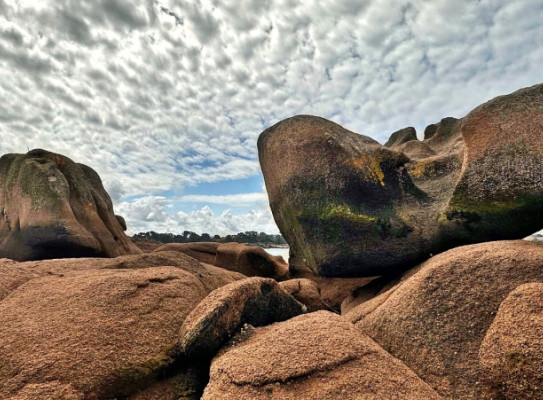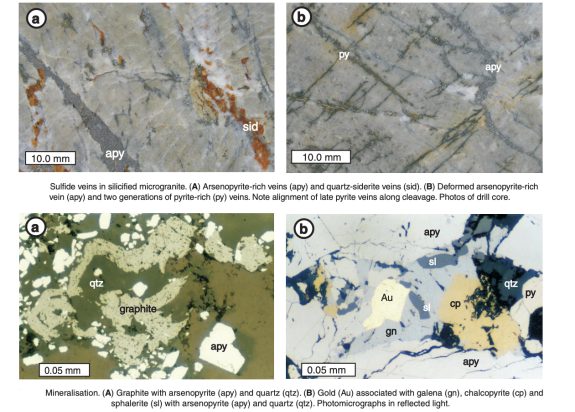Intrusion-related gold systems

Intrusion-related gold systems (IRGS) represent a distinctive and economically significant style of mineralisation that offers valuable opportunities not only for gold, but also for a suite of associated critical elements.
These systems form in unique geological and tectonic settings and are recognised for their subtle but diagnostic geochemical and alteration signatures, making them targets for modern exploration, particularly in regions beyond traditional porphyry or orogenic systems.
Characteristics of intrusion-related gold systems overlap those of other deposit types, including base and precious metal-bearing porphyry deposits, alkalic Cu-Fe-Au deposits, and tungsten-, tin- and molybdenum-rich systems, however, they exhibit a unique combination of geological, genetic, and exploration characteristics worthy of separate classification.
Geological and Geochemical Characteristics
IRGS are typically hosted in reduced I-type or S-type granitoid intrusions, with oxidised magmas being rare. These granites act as both the heat source and the source of metal-rich fluids, driving hydrothermal circulation that ultimately forms mineralised zones. One of the defining features of IRGS is their metal association: gold is accompanied by elements such as bismuth (Bi), tellurium (Te), tungsten (W), tin (Sn), antimony (Sb), and molybdenum (Mo). Importantly, copper is generally not enriched at a regional scale, a key contrast with porphyry copper systems.
Mineralising fluids in IRGS are typically high-temperature and saline, derived from the crystallising intrusion and often interacting with external brines from surrounding sediments. These interactions create predictable alteration patterns that can aid exploration. Alteration zoning commonly progresses from shallow vuggy quartz and carbonate-alunite-sericite assemblages, to intermediate biotite and potassic feldspar, and deeper scapolite-actinolite-albite zones that may resemble skarns or porphyry roots. These alteration halos often correlate with vertically zoned metal assemblages, with gold-silver near the surface, Pb-Zn-Cu and Mo at mid-levels, and deeper associations of Fe-Cu-Au, sometimes enriched in cobalt, uranium, or rare earth elements.
Tectonically, IRGS tend to form during the transition from compressional to extensional regimes—typically after the peak of orogenic gold formation. They are often associated with lithospheric thinning and asthenosphere upwelling in back-arc settings adjacent to fragmented craton margins. This makes them excellent targets in structurally complex regions, particularly where reduced intrusions are emplaced in older continental blocks.
Examples of Notable IRGS Deposits
Globally recognised examples include:
- Fort Knox in Alaska, a gold-dominant system with notable tungsten and bismuth by-products
- Kidston and Red Dome deposits in Australia, which illustrate the complex magmatic and hydrothermal interplay characteristic of these systems
- Dublin Gulch in Canada is another classic IRGS example, known for its extensive metal zoning and alteration patterns that guide exploration
Exploration Strategies and Tools
Exploring IRGS systems successfully requires a multi-disciplinary approach.
- Geochemical methods such as soil gas surveys and lithogeochemical profiling help identify buried systems and trace metal vectors.
- Advanced geophysical techniques, including 3D inversion of magnetic and gravimetric data, can image intrusive bodies and alteration zones.
- Remote sensing, especially infrared-based tools like ASTER, is particularly effective in arid environments for mapping alteration halos.
- On the ground, field recognition of alteration minerals—biotite at mid-levels, actinolite at depth—combined with understanding metal zoning can inform drilling decisions.
- Perhaps most crucially, integrating diverse datasets—geophysical, geochemical, and geological—maximises the effectiveness of targeting. Regions where multiple anomaly types cluster are often the most prospective and should be prioritised.
Intrusion-Related Gold Systems in New Zealand
The gold deposit in New Zealand that most closely resembles an intrusion-related gold system (IRGS) is Sams Creek, located in northwest Nelson. There are still several unanswered questions about Sams Creek and its classification is still open to debate. A comprehensive description of the deposit and an associated mineral systems exploration model were provided by Christie (2019).
The mineralisation at Sams Creek is hosted within a peralkaline granite dyke, up to 60 meters wide and a strike length of approximately 20 km, intruded into Lower Paleozoic sedimentary rocks. The dyke comprises porphyritic granite with phenocrysts of perthite, arfvedsonite–riebeckite amphibole, and quartz, along with accessory ilmenite and rutile.
Gold mineralisation primarily occurs in stockwork and irregular fracture veins containing arsenopyrite–pyrite–quartz–ankerite–siderite, with minor galena, sphalerite, pyrrhotite, and graphite. Siderite/ankerite/quartz veins are common and are present predominantly in the mineralised granite and to a lesser extent in adjacent, unaltered metasedimentary rocks. A late mineralising phase (T5) in the dyke, identified by Nazimova et al. (2014), includes gold-bearing quartz–carbonate veins hosting the REE-fluorocarbonate mineral bastnaesite [Ce, La(CO₃)F].

Initial models proposed that the mineralising fluids were of metamorphic origin (Windle & Craw, 1991). However, recent studies increasingly support a magmatic source. Faure & Brathwaite (2006) suggested a hybrid system between a reduced Au–Bi deposit and an alkaline intrusive gold system. Christie (2019) proposed an alkali intrusion-related system, while Angus (2014, 2016) and Lee (2016) contend that Sams Creek aligns more closely with a classic IRGS.
Nonetheless, key questions remain—particularly regarding the timing of dyke emplacement relative to gold mineralisation. Tulloch & Dunlap (2006) dated the dyke at 319 ± 8 Ma (Carboniferous) using Ar–Ar methods on amphibole. Phillips (2015) obtained a significantly younger age of 109 ± 9 Ma (Cretaceous) for the mineralisation via U–Pb dating of hydrothermal zircon. The association of mineralisation with D3 deformation (Angus et al., 2016) suggests that gold emplacement may have occurred well after dyke intrusion, potentially linked to a younger, deeper granite body.
Exploration efforts have thus far focused on the Main Zone, a 600-m-long mineralised corridor. According to Siren Gold, the Indicated and Inferred Mineral Resources (reported in accordance with the 2012 JORC Code) are currently estimated at 8.9 million tonnes grading 2.82 g/t Au, containing a total of 807,772 ounces of gold.
Key Challenges and Best Practices
Exploration for IRGS is not without challenges. The genetic complexity of IRGS, driven by overlapping magmatic and hydrothermal processes, demands a nuanced understanding of intrusion composition and fluid evolution. Prioritising targets requires both high-resolution data and a broad regional view. While advanced technologies offer unprecedented insight, traditional techniques like field mapping, rock sampling, and geochemical surveys remain fundamental.
IRGS deposits offer significant gold potential, especially in areas where traditional porphyry or orogenic systems may not occur. By recognising their geochemical and alteration signatures, exploration geologists can efficiently target these systems. The combination of modern technologies and foundational geological methods enhances the best chance for discovery in these prospective systems.
References and additional reading
Angus P, Jongens R, Phillips M, McCulloch M, Nazimova Y, Ryan G. 2016. Exploration update (2011–2015) on the Sams Creek porphyry gold deposit, North-west Nelson. In: Christie AB, editor. Mineral deposits of New Zealand – exploration and research. AusIMM Monograph. 31:209–216.
Angus, P. (2014) An update on the Sams Creek porphyry gold deposit, northwest Nelson, New Zealand. AusIMM New Zealand Branch Annual Conference. Hamilton, New Zealand: AusIMM New Zealand Branch.
Baker, T., Pollard, P.J., Mustard, R., Mark, G., Graham, J.L., 2005. A Comparison of Granite-Related Tin, Tungsten, and Gold-Bismuth Deposits: Implications for Exploration. SEG Discovery, 5-17.
Brathwaite R L and Faure K, 2004 - The Sams Creek Peralkaline Granite Hosted Gold Deposit, Northwest Nelson,New Zealand - A New Variant on Alkaline Intrusion-Related Gold Deposits: Pacrim 2004 Conference, Adelaide, 19-22 September, 2004, AusIMM, Melbourne, pp 127-133
Christie AB. 2019. Introduction to New Zealand hard rock gold deposits and their exploration models. New Zealand Journal of Geology and Geophysics. 62(4):394–413. https://doi.org/10.1080/00288306.2019.1653328(external link)
Faure K, Brathwaite RL. 2006. Mineralogical and stable isotope studies of gold-arsenic mineralisation in the Sams Creek peralkaline porphyritic granite, South Island, New Zealand. Mineralium Deposita. 40:802–827. doi: 10.1007/s00126-005-0013-y
Groves, D.I., Santosh, M., Zhang, L., Deng, J., Yang, L.-Q., Wang, Q.-F., 2021. Subduction: The recycling engine room for global metallogeny. Ore Geology Reviews 134, 104130.
Hart, C.J.R. (2007). “Reduced intrusion-related gold systems. In Mineral Deposits of Canada: A Synthesis of Major Deposit Types, District Metallogeny, the Evolution of Geological Provinces, and Exploration Methods”; Goodfellow, W.D., Ed.; Geological Association of Canada, Mineral Deposits Division, Special Publication: St. John’s, NL, Canada; Volume 5, pp. 95–112.
Lee, R. J. (2016). Carbonate Alteration of the Sams Creek Gold Deposit (Thesis, Master of Science (Research) (MSc(Research))). University of Waikato, Hamilton, New Zealand. https://hdl.handle.net/10289/10730(external link)
Nazimova, Y. (2013). Mineralogical report prepared for Sams Creek Gold. Internal Report, NZ Exploration Ltd.
Phillips M. 2015. U-Pb dating of the Sams Creek dike; implications for genesis and exploration. In Proceedings 48th Annual Conference, New Zealand Branch of the Australasian Institute of Mining and Metallurgy; p. 351–363.
Thompson, J.F.H., & Newberry, R.J. (2000). “Gold deposits related to reduced granitic intrusions.” Reviews in Economic Geology, 13, 377-400.
Tulloch, A. (1992). Petrology of the Sams Creek peralkaline granite dike, Takaka, New Zealand. New Zealand journal of geology and geophysics, 35(2), 193-200.
Tulloch, A., & Dunlap, W. (2006). A Carboniferous 40Ar/39Ar amphibole emplacement age for the Au‐bearing Sams Creek alkali‐feldspar granite dike, west Nelson, New Zealand. New Zealand Journal of Geology and Geophysics, 49(2), 233-240.